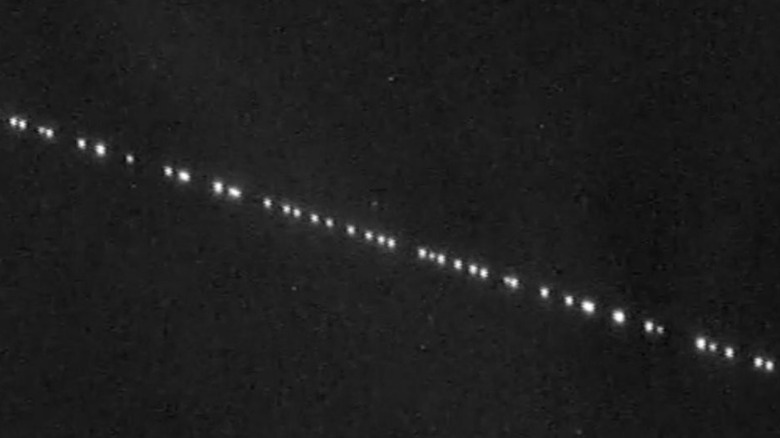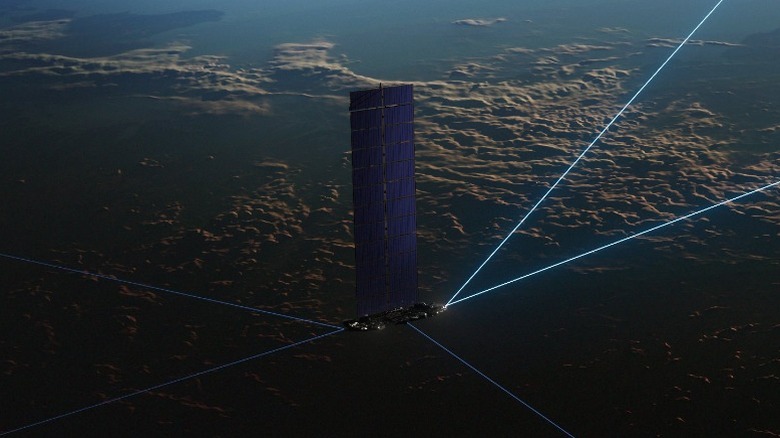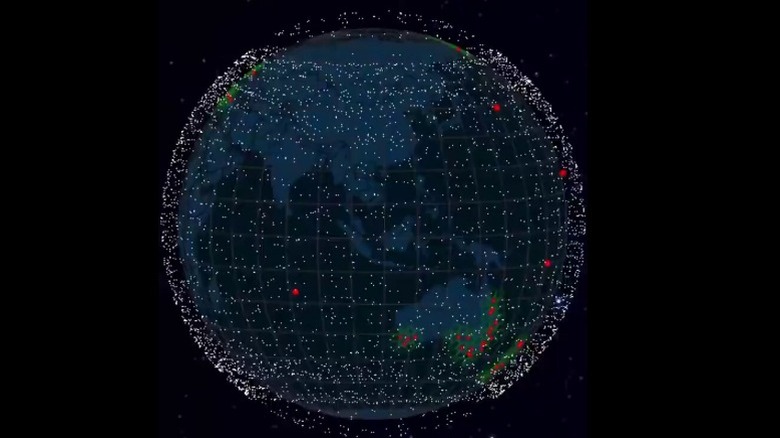What Do Starlink Satellites Look Like And Can You Track Them?
Have you looked up at the night sky recently and seen a streak of light flash across that black void between the stars? It might have been a plane or an asteroid, but it also may have been one of Starlink's satellites. Using thousands of interconnected sites known as mega-constellations, this internet-providing technology was developed, launched, and is currently operated by SpaceX. These satellites were created with the goal of providing high-speed, low-latency internet to remote areas that aren't usually able to receive it. There are currently well over 6,000 Starlink satellites in low orbit over the Earth, and the company eventually hopes to put that number all the way up to 42,000. Each satellite has a five-year life span. The service is a bit on the expensive side for most users, but it may be the only option for people in certain areas without access to fiber or cable internet.
With so many Starlink satellites in the sky, many amateur astronomers have found themselves wondering what these orbiting bodies look like. People are curious as to how to spot them from the ground, what they look like up close, and if there is any way of tracking their paths so you can get a glimpse of one when they happen to swing around. Fortunately, all of this information is readily available from various astronomical organizations, and from Starlink itself.
What do Starlink satellites look like from the ground?
You don't need to break out the telescope to get a look at a nearby Starlink satellite. These devices are bright enough and low enough in the Earth's orbit that you can actually see them from the ground with the naked eye, particularly during the period shortly after their launch. What's more, they're pretty easy to identify from other satellites due to their unique lighting pattern. Of course, you'll still need to be in an area without an abundance of light pollution or clouds so that you can have a clear view of the sky, though the service itself still works fine on cloudy days.
From the moment Starlink launched its first 60 satellites, observers noticed that they leave a unique trail of dotted lights that some have compared to a string of pearls against the night sky. This phenomenon is what's known as a satellite train.
"Traveling at the same altitude and speed, these satellites initially orbit the Earth in a cluster. This is what we see as the "train,"" says Starwalk. "Starlink satellites appear as a "train" of lights for several days after launch. During this time, they're easily visible to the naked eye." This unique pattern is unlike anything else that you're likely to see in the night sky, so it makes it pretty easy to identify as a series of Starlink satellites. You can still see them after the train breaks apart as each satellite enters its own individual orbital pattern, but it isn't nearly as bright or easy to distinguish from other celestial phenomena.
What do Starlink satellites look like up close?
As interesting as Starlink satellites look when they are rocketing through the stratosphere, they're just as interesting to look at up close. "Each satellite features a compact, flat panel design that minimizes volume, allowing for a dense launch stack to take full advantage of SpaceX's Falcon 9 rocket's launch capabilities," the company states. This means that they are primarily rectangular in shape, though they can be oriented in two different configurations: They are folded flat in the "Open Book" configuration during ascent, and then the base of the satellite rotates outward, placing the satellite in the "Shark-Fin" orientation which it maintains during operation.
And with a glimpse of the future, views from Starship entering Earth's atmosphere were made possible by Starlink.
Soon, Starship will launch our V3 Starlink satellites, which will add 60 Tbps of capacity to the network per launch – more than 20x per Falcon 9 launch today pic.twitter.com/wgxU1Bpe1h
— Starlink (@Starlink) December 31, 2024
Onboard each of them is some pretty incredible technology as well. Every satellite has a series of navigation sensors that track the stars to determine the satellite's location, three optical space lasers that are able to transmit 200 Gbps of data and are used to form the global internet mesh, five Ku-band phased array antennas plus three dual-band antennas for bandwidth connectivity, ion propulsion systems that use argon thrusters, a dual-solar array and high capacity battery power system, and four reaction wheels to provide altitude control.
Can you track Starlink satellites?
Customers of the Starlink service don't really need to worry about knowing where the satellites are at any given time. They receive an automated dish called "Dishy" which is able to automatically detect and align itself with the nearest satellite in order to receive an optimal connection. That said, there are still quite a few people out there who might be interested in learning if there is a way to track this barrage of satellites across the night sky. Those people are in luck, as there are a handful of services out there that do it for you.
One of these is a website called SpaceX Starlink Satellites Tracker. You can enter your country and city to find local visibility times, or you can get an even more precise result by entering your exact latitude and longitude. Once you've entered your location, the site will provide you with the date and time that a Starlink satellite will be passing overhead. This site also gives you the name of the specific satellite that will be visible and predicts what part of the sky it will occupy relative to your position, how long it will remain visible, and how bright it will be. To make choosing easy, the site has also organized these flyovers into three categories ranked by visibility.
This is probably the easiest way to plan a Starlink sighting, though you can also use the included satellite tracking functions that come with certain kinds of astronomy software, such as Stellarium, Satellite Tracker, and SkySafari.



